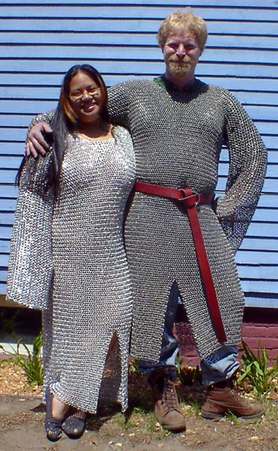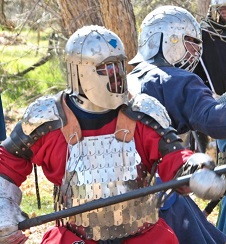Chain Armor
Chain, although it makes for an attractive and authentic looking fighter, is not an effective protection against crushing weapon. It is primarily useful for preventing the penetration of slashing attacks, which given the lack of “live steel” in SCA combat is not something a fighter will encounter. It is really only useful in situations where is hangs away from the body, and can thereby have time to slow down incoming shots by transferring the energy of the attack into moving the mail around. If used as primary body armor, it has no time to slow the shot down and the attack energy is transferred into the defender. Ouch. Chain shaped bruises. For the purpose of this discussion we will not consider chain a practical variety of armor for SCA fighting.
If you are practicing LARP fighting, chain armor is not what you want for fighting. It is expensive, and can weight a great deal! If you wear a stainless halbrek you will learn the expression "Sit whenever you can", as the armor is extremely heavy. Chain armor is also noisy, which is not what you want when sneaking past monsters. Finally, chain does not provide the best armor point value in most systems. You are better off with the 'magical plate' armor that we sell.
Steel and Leather
Steel and Leather types are two other options and are time tested varieties. They give good protection (assuming good fit) but can be a maintenance hassle for a variety of reasons.
1) Repairs are slow are require specialized tools. The armor is held together with either rivets or riveted straps. These straps, be they leather or synthetic, are subjected to tremendous strain which is concentrated at the point of attachment. This causes frequent and annoying failures due to rivets or straps failing and they always seem to fail at the most inconvenient time. How does one fix a rivet/strap on the field? Required parts are hammer, anvil, rivets, skill, time. "ain't nobody got time for that".
2) Steel rusts, and bends leather hardens, cracks and mildews, cloth padding grows sweat based life forms. Rivets break, leather straps fail. All of these forces of entropy act upon your armor to kill it. Continual maintenance is required to slow the process down.
 Weight Is Not Safe
Weight Is Not Safe
Heavy armor types are certainly the cause of numerous injuries. Carrying around an extra 30-50 lbs of armor while performing aerobic exercise, often in the hot sun, will most certainly put great strains upon a person. Sore knees can be the least of your problems during a hot battle on the field. Heat stroke is a very serious concern to people running around in hot weather covered in armor.
Lighter armor which does not compromise on safety give it’s owner a superb advantage. Have you ever tried to sprint with a backpack full of concrete? That’s the weight of conventional steel armor. Now try sprinting with a backpack with a few books in in. Better?
Plastic armor, by virtue of it’s strength and durability can be padded and vented in such a way as to make it comfortable, even in hot weather. Not only is it better on your joints, it's safer to use.
We love the look of plate armor. If you are in great shape and can handle the weight while running and can afford a custom fitted set it can really work for you. But if you are like many of us and just trying to get onto the field and have a great time, there are other alternatives.
